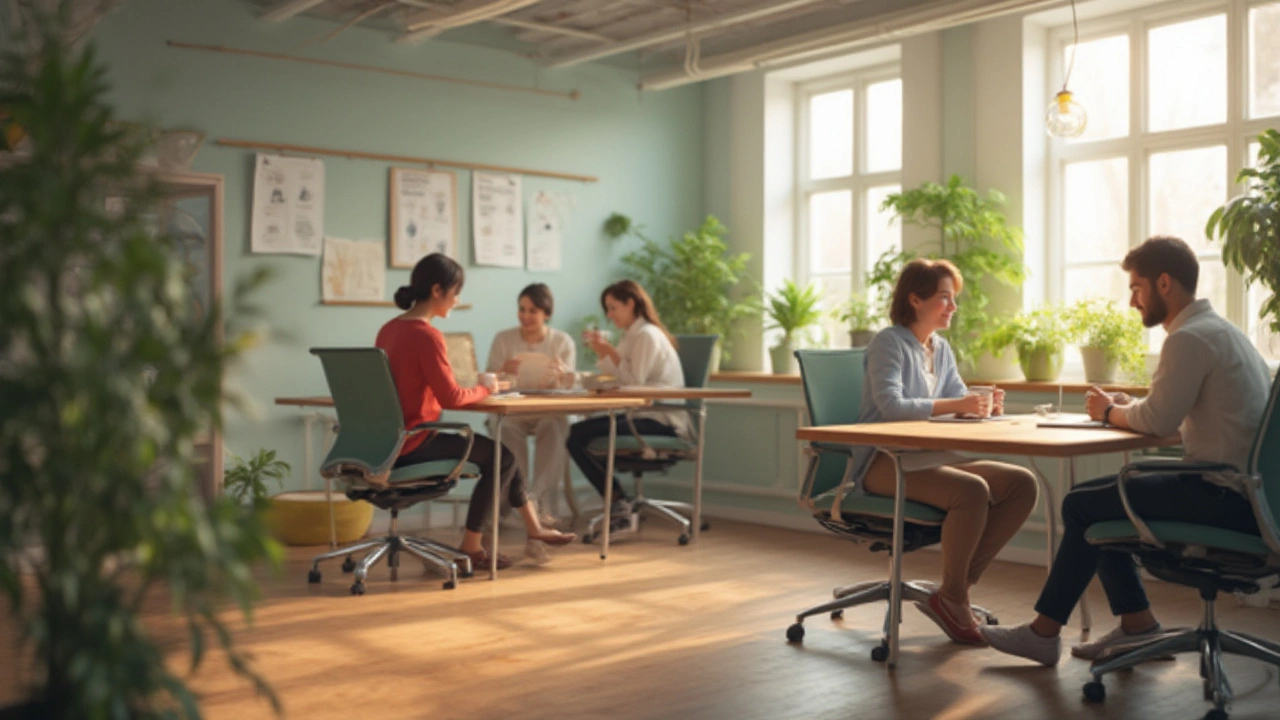Imagine this: It's the middle of a workday. Your shoulders feel like concrete and even your brain feels knotted. A chair massage isn't just a nice-to-have; it's the modern antidote. Stress doesn't ask permission to visit, and for most of us, it pitches a tent somewhere between our shoulder blades. That's exactly where chair massage steps onto the scene — quick, effective, and surprisingly powerful. People everywhere are discovering that fighting stress doesn't always mean taking a whole spa day. Sometimes, all it takes is a well-placed chair and ten minutes. Sound too simple? The research begs to differ.
The Science Behind Chair Massage and Stress
Let's cut straight to what actually happens in your body when you plop down for a chair massage. Your muscles send up a white flag. The body’s fight-or-flight system finally gets a timeout. Researchers at the University of Miami’s Touch Research Institute—a world leader in massage therapy research—have found that chair massages lower cortisol levels, which is your main stress hormone, by up to 31%. At the same time, they bump up endorphins and serotonin, your natural mood-lifters. This isn’t just some feel-good placebo. The chemicals in your bloodstream, the ones directly tied to feelings of stress and anxiety, take a noticeable dip.
To put it in real-life terms: participants who received regular chair massages in a 2013 clinical trial at Cedars-Sinai Medical Center reported not only less tension, but also better sleep and more energy. Their immune cells even worked better—measured straight from blood tests before and after sessions. These aren't fringe numbers either; more than a dozen peer-reviewed studies show similar results. Here's what a typical 15-minute session can do for you, according to recent data:
| Benefit | Percentage Change After Massage |
|---|---|
| Cortisol (stress hormone) | -31% |
| Serotonin (well-being) | +28% |
| Depression symptoms | -16% |
| Muscle tension | -38% |
But numbers aside, the most powerful feedback often comes from people who never thought a quick massage could make such a difference. "I felt lighter," is how one overworked accountant described her first chair massage. It doesn’t erase life’s problems—but it certainly makes them easier to carry.
Why Chair Massage Works for Busy Lives
One reason chair massage has caught fire in offices and busy city spaces is its low-overhead magic. You don’t need to strip down or take a shower after. The therapist sets up a portable, ergonomic chair, and you stay fully clothed. No awkward moments, no tricky logistics. That’s why you’ll find chair massage in surprise places: airports, conferences, tech offices, even at farmer’s markets.
Ever sat through a long meeting just wishing for a reset button? Many companies—including big names like Google and Apple—set up chair massage stations as part of their wellness programs. They’ve noticed fewer complaints of back and neck pain, and sick days start to shrink. It’s not just about muscle relief. According to the American Institute of Stress, businesses lose up to $300 billion a year to stress-related issues—think absenteeism, mistakes, and turnover. A quick session in a massage chair is cheaper than a single lost workday. It’s no surprise office surveys routinely list chair massage as employees’ “most requested perk.”
Mobility is what really sets chair massage apart. The average appointment lasts just 10 to 20 minutes. You can get back to your emails or patient load, only now you’re not hunched or clenching your jaw. Massage therapists focus on the exact spots where people store their tension: shoulders, upper back, neck, arms, and hands. There’s even research from the Mayo Clinic showing that just one chair massage can significantly reduce both headache intensity and frequency for the rest of the day.
- No need to undress
- No messy oils
- Sessions as short as 10 minutes
- Portable for almost any location
- Targets common stress hotspots
In our constantly “plugged in” world, the best solutions are the ones you can actually fit in. Chair massage is less about escaping your routine, and more about building health into it.

The Technique: What Really Happens in the Chair
If you’re new to the idea, you might be wondering what chair massage actually feels like. Think of an expert hunting for knots, tension, and micro-stress points. Professional therapists use a blend of Swedish, acupressure, and sometimes Shiatsu techniques, all tailored for a chair. They’ll check in with you about how much pressure you want. No need to make small talk if you don’t want to—many people close their eyes and simply focus on their breath.
The chair itself props your body forward, allowing access to muscles that are hardest at work when you sit at a desk. Therapists start with the shoulders and upper back, often finding sore spots even you didn’t know existed. Then the attention moves to the neck, arms, and hands. These areas take the brunt of typing, scrolling, and tech tension. Simple techniques like kneading, friction, tapping, and gentle stretching help unwind tight muscles and boost circulation—picture the difference between water flowing through a squeezed hose versus a clear pipe.
Don’t expect to drift into a dream-like state; chair massage isn't about putting you to sleep. It’s about waking up your body’s repair system. Some people even report a kind of clarity afterward, like someone just lifted off a heavy coat. That surge of blood flow to the brain isn't just a metaphor—one Stanford study found people performed better on creative problem-solving tests after just a single 15-minute session.
- Kneading and rolling relax trigger points
- Gentle stretches boost range of motion
- Acupressure lifts tension in deep muscle fibers
- No pain—just that good ache signaling release
If you’re worried about lingering soreness or looking awkward, don’t be. Trained therapists read your body’s responses in real time. Most people hop up after a session feeling taller, looser, and ready to tackle what’s next.
How to Get the Most from Your Chair Massage
You’ve got a short window of time—make it count. Start by sitting comfortably and taking a few deep breaths before the session begins. This gets your brain and muscles out of predator mode. If there’s a specific spot where you feel tight or achy, let the therapist know. They can focus there for more targeted relief.
Hydrate before and after your massage. Just like after a workout, massage helps flush out metabolic waste from your muscles. Water speeds up this process and prevents any next-day soreness. If you can, avoid caffeine right before; it can make muscles twitchy and less responsive to massage techniques.
- Wear loose, comfortable clothing—nothing too tight around the neck or shoulders
- Silence your phone and avoid distractions
- Arrive a couple minutes early to settle in
- Breathe deeply and slowly during the session
- Afterward, roll your shoulders and neck to extend the benefits
If your job or schedule doesn’t offer regular access, don’t write the idea off. Neighborhood spas increasingly offer express chair massage. Many independent therapists also book home visits. Apps like Zeel and Soothe make same-day chair massage bookings just as easy as ordering takeout. Some companies even subsidize in-office massage days for remote employees. You don’t need to be a CEO to justify this; the goal is to give your nervous system a genuine break. Your body doesn’t care whether relaxation comes in a private spa or a converted break room.
Pro tip: if you’re dealing with specific chronic pain—like tension headaches or carpal tunnel—mention this upfront. Therapists certified in medical or orthopedic massage can often tailor the session to support your doctor’s recommendations.

Chair Massage in Today’s World: Trends and What’s Next
The past decade has seen chair massage level up from “luxury” to “practical tool.” The American Massage Therapy Association reports that, as of 2024, over 40% of large US companies now offer onsite chair massage as part of their employee benefits. That’s up from just 16% a decade ago. The rise of hybrid work hasn’t changed things—instead, more providers are rolling portable chairs into home offices. Event planners have caught on as well: you can spot chair massage stations at music festivals, sporting events, and even pop-up mental health clinics.
Universities now offer free chair massages during finals week, resulting in lower self-reported anxiety and fatigue scores among students. Tech innovator Logitech even started offering regular onsite sessions, tracking a measurable drop in repetitive strain injuries among their staff—something that saved them money on insurance payouts. This isn't just an American thing, either. In Japan, "Fatigue Recovery Lounges" inside busy metro stations offer brief, walk-in chair massages for commuters. Amsterdam's international airport provides similar relaxation pods that are never empty.
We’re also seeing a change in how people think about self-care. For a long time, massage was seen as pure pampering—reserved for vacations or special occasions. These days, it’s a healthcare tool, right up there with standing desks and ergonomic chairs. It’s a key player in the corporate wellness movement. As wearable device data pours in, more people are realizing that reducing stress is often the missing link to better sleep, stronger immunity, and even sharper focus at work.
With remote work here to stay, digital platforms are getting in on the act. Apps not only help book sessions but can bundle them with stretches or mindfulness routines for even better stress relief. Expect to see more virtual guidance on using massage tools at home, too. The best part? The barrier to entry lowers every year—a good thing, since modern life doesn’t look any less stressful than it did yesterday.
So, next time your brain and back are begging for relief, forget the complicated fixes. The chair massage is the secret weapon hiding in plain sight—quick, effective, and about as fuss-free as relaxation gets. Maybe, in a world hooked on coffee and chaos, it’s finally time we gave our shoulders a little more love.


 Health and Wellness
Health and Wellness